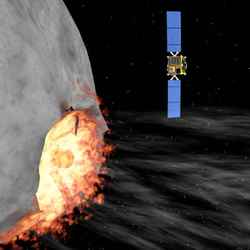
Artist’s impression of ESA’s Hildalgo spacecraft. Image credit: ESA.Click to enlarge
Telescope facilities across the world are watching the skies for rocky remnants from outer space on a collision course with planet Earth. Currently one or two of these so called ‘Near Earth Objects’ [NEOs] are being recorded each day but fortunately for humankind the vast majority are the size of a human fist and pose no threat. Nevertheless, the presence of large impact craters on Earth provides dramatic evidence of past collisions, some of which have been catastrophic for the planet’s species, as was the case with the dinosaurs. This week, experts from across Europe and the US met in London to consider current and future efforts to monitor NEOs in order to better predict those with Earth impacting trajectories, since it is inevitable that a catastrophic collision will happen again in the future.
Professor Monica Grady, a leading expert on meteorites from the Open University explains, “It’s simply a question of when, not if, a NEO collides with the Earth. Many of the smaller objects break up when they reach Earth’s atmosphere and have no impact. However, a NEO larger than 1 km will collide with Earth every few hundred thousand years and an NEO larger than 6 km, which could cause a mass extinction, will collide with Earth every hundred million years. And we are overdue for a big one!”
NEO’s, remnants from the formation of the inner planets, range in size from 10 metre objects to those in excess of 1 km. It is estimated that 100 fist sized meteorites, fragments of NEO’s, fall to Earth on a daily basis but larger objects impact with Earth on a much less regular basis.
Professor Alan Fitzsimmons from Queens University Belfast is a UK astronomer (supported by the Particle Physics and Astronomy Research Council) involved in the study of NEO’s, using telescope facilities such as the European Southern Observatory’s Very Large telescope in Chile, the Isaac Newton Telescope in La Palma and the Faulkes Telescope in Hawaii. He said, “By the end of the decade as new dedicated facilities, such as the Pan-STARR project in Hawaii, come on line there will be a quantum leap in the discovery of NEO’s – with rates anticipated to increase to hundreds per day. This will provide us with a greater ability to determine which ones are on a potential Earth colliding trajectory.”
Studies of one such asteroid (Apophis), which was discovered in June2004, have shown that there is a low probability that this object will impact the Earth in 2036. This has raised a whole series of issues about the prospect of deflecting the asteroid before a very close approach in 2029. Government’s across the world are looking at the issue and in particular at the technologies and methods required to carry out an asteroid deflection manoeuvre in space.
The European Space Agency’s NEO Mission Advisory Panel (NEOMAP), of which Professor Fitzsimmons is a member, has selected “Don Quixote” as their preferred option for an asteroid deflecting test mission. Don Quixote would comprise two spacecraft – one of them (Hildalgo) would impact the asteroid at a very high relative speed while the second spacecraft (Sancho) would arrive earlier to monitor the effect of the impact to measure the variation of the asteroid’s orbital parameters. This attempt to deflect an incoming NEO would act as a precursor mission with the primary objective of modifying the trajectory of a “non-threatening” asteroid.
Richard Tremayne-Smith, from the British National Space Centre, heads up the coordination of UK NEO activity and helps provide an international lead on NEO efforts on the issue. He said, “NEO collisions are the only known natural disaster that can be avoided by applying appropriate technology – and so it is the interest of Governments across the World to take interest in this global issue. Here in the UK we take the matter very seriously and progress is being made in taking forward the recommendations of the UK NEO Task Force Report in an international arena.”
The current method of studying NEOs is achieved through a combination of 3 different methods:- the study of meteorites to understand their structure and composition; earth based astronomical observations of asteroids; and space based observations and encounters with asteroids.
Much can be understood about the nature of asteroids from the study of meteorites which are fragments of asteroids that have broken up and fallen to Earth. Professor Grady explains how the ground based study of meteorites is crucial to future plans for dealing with asteroids.
“In order to define successful strategies for deflecting asteroids that might collide with Earth, it is essential to understand the material properties such as the composition, strength and porosity of asteroids. By putting together such information with data from both ground based and space based studies we can begin to build an accurate picture of these diverse phenomena.”
UK scientists are involved in a number of other missions which will also be investigating the properties of asteroids and comets. This includes NASA’s Stardust mission which collected samples from Comet Wild 2 in January 2004. These samples are set to return to Earth in January 2006 and scientists from the Open University will be involved in their analysis. The European Space Agency’s Rosetta mission which is currently on route to Comet Churyumov-Gerasimenko will pass by two asteroids, Steins and Lutetia, before reaching its target in 2014, gathering data about their properties as it flies past.
Original Source: PPARC News Release
